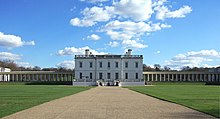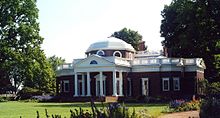Palladianism
Palladianism describes a classicist style of architecture that is based on the work of the architect Andrea Palladio and his successors such as Vincenzo Scamozzi . Palladio designed and built palaces and villas in Veneto as well as churches in the city of Venice itself around the middle of the 16th century . He also exerted a great influence on posterity with the architectural theoretical work "I quattro libri dell'architettura", which took place in Venice in 1570 appeared.
Style features
Due to its comparatively clear design, simple compositional principles and easily comprehensible rules, architecture based on the model of Palladio has been widely used since the 17th century. The “Quattro libri”, which was translated into English in 1715 by Giacomo Leoni , who worked in England, made a particular contribution . Even lay architects and amateur architects could successfully try their hand at Palladio-style designs. Especially in the Protestant countries of Northern and Western Europe, Palladianism shaped architecture. It distinguishes itself from the Roman Baroque , which is perceived as "Catholic", by means of stricter, more classical forms . In contrast to the Baroque, Palladianism has no concave-convex facade relief, no triumphant summit and no moving outlines. Palladianism is characterized by a clear, emphatically antiquated use of the classical forms of construction, for example through temple fronts and colossal orders . The Palladian motif is often used for wall openings , in which a higher central arch position is flanked by two narrow, straight openings.
distribution
Starting in Italy, the Palladian style also influenced architecture in the Protestant countries of north-western Europe and America from the 17th century. Jacob van Campen is considered to be the founder of Palladianism in the Netherlands. In England in the early 17th century he was best known for the buildings by Inigo Jones . These include the Banqueting House in London and Queen's House in Greenwich . In the early 18th century, liberal landowners resorted to Palladian villa models, such as Richard Boyle, 3rd Earl of Burlington with Chiswick House . Palladian motifs became important again in classicism around 1800 and in so-called revolutionary architecture .
In the young United States, whose founding generation saw the Roman Republic as a model for their new state, Palladian ideas fell on fertile ground. Examples of this are the buildings designed by Thomas Jefferson for his Monticello country estate and the University of Virginia . As a result, Palladianism influenced the development of the American colonial form of the Georgian style , also known as the Greek Revival or Antebellum architecture . Today the Briton Quinlan Terry has designed highly acclaimed Palladian villas and country houses.
In Munich , Karl von Fischer built the Prinz-Carl-Palais in the early classicism style between 1804–1806 , based on the Palladio he admired.
Representative

The architects who are attributed to Palladianism include:
- Inigo Jones (1573-1652)
- John Webb (1611–1672), son-in-law and assistant to Inigo Jones
- Roger Pratt (1620-1684)
- Colen Campbell (1676-1729)
- William Kent (1685-1748)
- Matthew Brettingham (1699–1769)
- Richard Boyle, 3rd Earl of Burlington (1694–1753)
- Alessandro Galilei (1691–1737),
- Edward Lovett Pearce (1699-1733),
- Thomas Jefferson (1743-1826)
- James Hoban , (around 1762–1831)
- Roger Morris (1695-1749).
See also
literature
- Andrea Palladio: The four books on architecture . Translated from the Italian and edited by Andreas Beyer and Ulrich Schütte. 3rd revised edition. Verlag für Architektur Artemis, Zurich et al. 1988, ISBN 3-7608-8116-5 , (based on the Venice 1570 edition I Quattro libri dell'Architettura ).
- Bruce Boucher: Palladio. The architect in his time . Hirmer, Munich 1994, ISBN 3-7774-6440-6 .
- Erik Forssman : Palladio's teaching building. Studies on the connection between architecture and architectural theory with Andrea Palladio . Almquist & Wiksell, Uppsala 1965, ( Acta Universitatis Stockholmiensis , Stockholm studies in history of art 9).
- Roland Freart: L'idée de la perfection de la peinture . Gregg International Publications, Farnborough 1968, (reprint: l'imprimerie de Jacques Ysambart, Mans 1662).
- Werner Oechslin : Palladianism. Andrea Palladio. Continuity of work and effect . gta Verlag, Zurich 2008, ISBN 978-3-85676-239-1 .
- Lionello Puppi: Andrea Palladio. The complete work . DVA, Munich 2000, ISBN 3-421-03253-X .
- Carsten Ruhl: Palladianism. From Italian Villa to International Architecture , European History Online , ed. from the Institute for European History (Mainz) , 2011, accessed on: June 15, 2011.
- Robert Tavenor: Palladio and Palladianism . Thames and Hudson. London 1991, ISBN 0-500-20242-7 .
- Manfred Wundram u. a .: Andrea Palladio 1508-1580 . Taschen-Verlag, Cologne 2004, ISBN 3-8228-2107-1 , (overview with all buildings, well illustrated).
Web links
- Palladianism in the great art dictionary by PW Hartmann
Individual evidence
- ^ Crescenzio, Daniela: Italian Walks in Munich, 2012, Volume 1, Page 87


